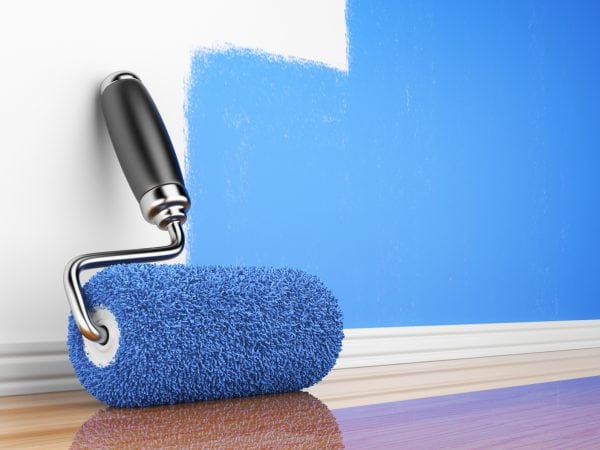If you are not a professional plasterer painter, even a simple question of which one to choose is better, a roller or a brush, can confuse you. You can use consumables and your time as efficiently as possible only with the right choice of paint tools.

Difficulty choosing
Naturally, when choosing a brush or roller to carry out painting work, you should choose only high-quality and professional tools. In order to whitewash the ceiling in the utility room, of course, you can save money and purchase a cheaper tool.
However, if you are going to paint or whiten a living room, office or a room with a lot of traffic - it is better to opt for a quality roller or brush. There are several reasons for this:
- During painting, a low-quality brush will almost certainly leave a pile on the walls. The same applies to the rollers. In some cases, especially when using thick glazes, enamels or water-based paints, the problem with the quality of the coating is already too late to change. The paint loses volume during drying and air bubbles, protruding fibers or hairs begin to appear on the surface. It is better to immediately opt for a reliable brush or roller, so as not to encounter unforeseen additional costs.
- To paint or whiten surfaces with professional tools is much more pleasant, faster and more convenient than cheap analogues. Dear brushes and rollers allow you to paint with a thick, even layer. This has an effect not only on the appearance of the ceiling or walls, but also on the life of the coating, its resistance to external factors.
- During painting, each task has its own specially created roller or brush. Proper use of the tool will save you from a large loss of paint, which can fall on the floor, increase the quality of finish, reduce the consumption of materials, and help you perform complex painting work even without preparation.

Brushes
This tool is a wooden, plastic or polymer base that fixes natural or artificial fibers in the form of a brush. Brushes are used to work with almost any kind of paint, including alkyd, oil, acrylic, latex.
It is important to know what type of paint will be used in order to choose the right brush for painting. For example, brushes with artificial fibers are used for more aggressive formulations, such as latex or acrylic.
The fact is that to maintain the paint fluid, powerful solvents are added to it, which can lead to the decomposition of organic fibers. This will lead to the fact that when painting the quality of the coating will deteriorate sharply due to the appearance of fragments of the bristles.
to contents ↑Tips for choosing brushes
- In order for the painting work to take place at a normal flow rate, so that the layer lays on the surface softly and evenly, it is better to choose a brush for painting with split ends. The fibers should be resilient, not broken when pressed, thick at the base and soft and thin at the ends.
- It is better to carry out painting work with such brushes that have a bristle length of at least one and a half times longer than the width. This rule applies to brushes with which you are going to paint the floor, walls or ceiling.
- Contrary to the misconceptions of many, brushes just bought in a store are not ready for work. They require mandatory soapy water to remove dust, debris, grease and broken bristles. Before painting the floor or ceiling, be sure to dry the brush.
- It is better to paint with dipping the brush at ½ the length of its bristles. This will ensure a normal flow, eliminate the dripping of paint on the handle.
- If you paint the wood floor or boards - work is along the fibers. Part of the brush pile will be lost depending on the quality of the coating. Process non-planed boards with cheap brushes.

Roller
The paint roller is a tool for working on areas. It may have a different coverage, depending on the tasks performed. The use of the roller is quite extensive, however, in most cases it is painting a large flat area. It is easy for them to paint the ceiling, walls and floor, but the roller is completely useless when working on curved objects of complex shape.
The soft working surface of the cylindrical part is called a fur coat. It allows not only to balance the flow rate, but also to give the ceiling, walls or floor a certain texture, which is impossible to achieve using an ordinary brush.
Distinguish large, medium and small rollers. With large rollers, it is better to carry out operations that are accompanied by a large consumption of material, for example, if you need to quickly whitewash the ceiling. Small ones are used for work in hard-to-reach places, for painting corners, junctions, butts. A professional painter always has these three sizes at hand for working on various surfaces.
Rollers have a higher cost, but they are more durable and can solve a number of narrow-profile problems. Depending on the material from which the pen and fur coat are made, the properties and characteristics of the tool are determined. In construction stores, you can find rollers from the following materials:
- foam rubber;
- felt;
- velours;
- fur of various animals (goat, sheep and even llama);
- mohair;
- Westan, polyester and other polymers.
If you are going paint the ceiling with acrylics or latex compounds - it is better to buy a roller made of synthetics, as this guarantees the quality of the paint. To work with oil paints, any rollers are suitable.

The larger the coat, the higher the paint consumption. This should be considered when buying rollers from velor or mohair. The roller takes many times more paint than a brush, which speeds up the work and reduces labor costs.
Roller advantages over brushes:
- The roller can be whitened, painted or treated over a huge area very quickly and easily for a house painter. A single roller pass can equal hundreds of brush strokes. It is especially convenient to paint the floor with a roller, even if it has an uneven surface, the work will be faster.
- The roller covers the surface evenly, even if it was not previously prepared.
- There is a huge selection of the type of texture for applying paint or other decorative coatings. Brushes are not designed to work with a large number of modern finishing materials, such as, for example, decorative liquid plaster.
- Lack of visible smears on the working surface.
Disadvantages:
- The cost of a quality roller is higher than the cost of a brush, however, if you buy only a fur coat for replacement, the roller will be a more profitable tool.
- It is impossible to process joints, corners, junctions.You will need brushes anyway.
- The roller has an extremely small resource of use. In the future, it is necessary to change at least a fur coat.
Paint roller or brush
Comparison is worth starting with the fact that the roller and the brush are not mutually exclusive things. To carry out high-quality painting work, the presence of both the first and second is required. The question is more correct - what is more effective in the work of a painter? And in what cases is it worth using a particular tool?
A few tips to make the right choice:
- The larger the area, the higher the efficiency when using the roller. Moreover, in large areas, stains, strokes, uneven application of paint are noticeable. Despite the fact that you can paint the ceiling or walls with a brush, spending more time, the quality will be extremely low.
- Paint roller can paint the surface almost without leaving a place, performing reciprocating motion. This is important when working in cluttered or cramped conditions. The brush requires simplified access to the work surface.
- The roller requires a special tray and containers for storing paint. This is not only additional costs, but also inconvenience to the painter, who must instead of one brush to hold several items at once during operation.
- Pile rarely drops out from the roller, which is very important when working with “light” paints that are laid with a thin layer.
- It is convenient to whitewash the ceiling and walls with lime with a large brush, but it is difficult to work with this material using a roller.
- A brush is an indispensable tool, even if you use a professional and high-quality roller - you will need to buy several brushes to work with corners. It is also necessary when painting window framessuch objects as pipes, radiators.
- The roller is often used to work with stencils, but they cannot draw any pattern. It’s best to whiten the roller over the stencil.
Therefore, each tool has its own advantages and disadvantages that allow them to be used efficiently, rationally to control the consumption of material, only depending on the type of painting work.





